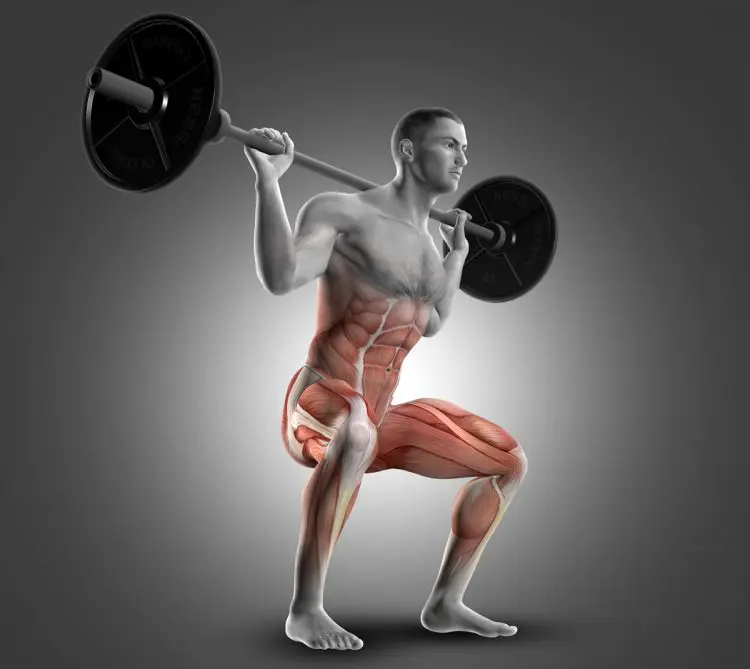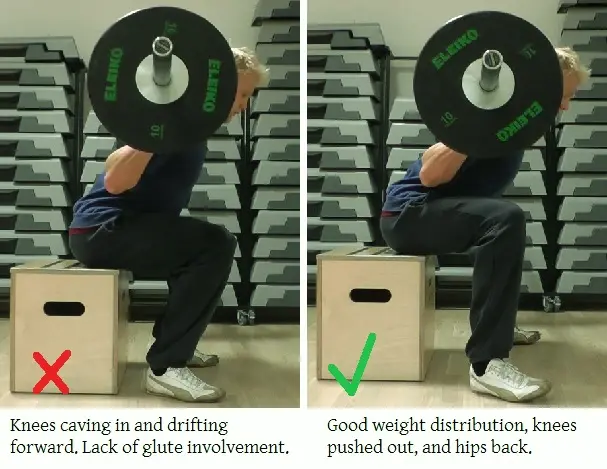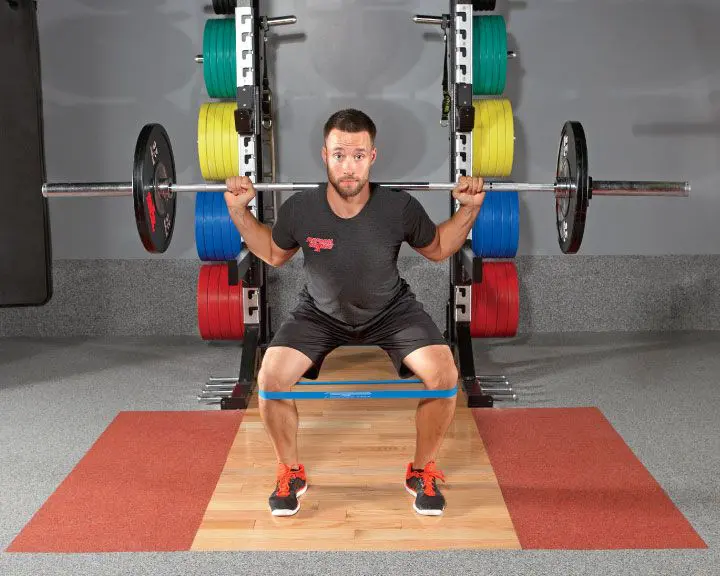Whether you want to build massive legs, increase your lower body strength, or improve your leg power for sports, squats can help. There are lots of different types of squats, including front squats, Zercher squats, overhead squats, goblet squats, pistol squats, and Bulgarian split squats, but many lifters favor the classic barbell back squat.
Barbell back squats put you in a very mechanically advantageous position so you can lift the heaviest weights in relative comfort. Plus, with the bar resting on your back, you don’t need to use your arms too much. Instead, you are free to focus on working your legs to the limit.
That’s not to say your upper body doesn’t play a part in back squats. It’s just that your arms aren’t as heavily involved as they are when you do things like Zercher, front, or goblet squats.
The squat is such a productive exercise that entire workouts have been built around the so-called king of lifts. You can experience the power of back squats for yourself in the famous old-school 20-rep squat routine. Six weeks of high rep squats will transform your body!
While we love the back squat, it’s also important to realize that variation is an essential part of effective program design. Even if you are a powerlifter, you should include variations of the back squat in your workouts to avoid training boredom and plateaus.
Level Up Your Fitness: Join our 💪 strong community in Fitness Volt Newsletter. Get daily inspiration, expert-backed workouts, nutrition tips, the latest in strength sports, and the support you need to reach your goals. Subscribe for free!
The good news is that there are lots of back squat variations you can use to keep your workouts fresh and productive. We’re not talking dumbbell or front squats here, but different ways to squat with a barbell on your back.
If you are bored of conventional back squats, or your progress has stalled, use these 12 variations to breathe new life into your lower body workouts.
12 Best Squat Variations
Whether you want to build muscle or increase your squat 1RM, these barbell back squat variations will help. Use them in place of standard squats or as a secondary assistance exercise after your main squat workout. Or, if you train your lower body twice a week, use your choice of alternatives in your second workout.
Most of these variations can be used with both high bar and low-bar squats. But, if you try one and it feels uncomfortable, move onto another variation to avoid injury. And, of course, it goes without saying you should always squat in a power rack or with a couple of strong spotters on hand. Getting stapled by a heavy barbell is no-one’s idea of a good time.
1. Paused Squats
Adding a mid-rep pause is one of the easiest ways to add a little variation to your squat workout. Pausing for 3-5 seconds while you are “down in the hole” will increase muscle-building time under tension and force you to explode up, which helps develop strength and power. Powerlifters use paused squats to teach them to blast through sticking points.
It’s up to you how long you pause at the bottom of each rep but, needless to say, the longer you pause, the harder this variation becomes.
How to do it:
- Unrack the barbell and adopt your usual squat stance. Brace your abs and pull your shoulders down and back.
- Push your hips back, bend your knees, and squat down as far as your mobility and knee health allows. (Read more about squat depth here.)
- Hold this position for the required time. Stay tight and do not relax your core.
- After your pause, drive the bar up as powerfully as you can and then repeat.
- You can apply this pausing method to many of the following squat variations.
2. Squats with Bands / Chains
Squatting with bands or chains increases the resistance as you approach lockout. This increases the tension on your quadriceps and encourages you to drive powerfully up and out of the hole, teaching you to use speed to blast through sticking points.
Bands and chains work in more or less the same way, but bands are cheaper and more portable, so you can get some and keep them in your gym bag. However, many gyms have chains, too, so use them if you’ve got them.
You can use bands or chains in conjunction with many of the other bench press variations in this article.
3. Unbalanced squats / One Side Loaded Squat
Squats ARE a leg exercise, but it’s impossible to do them without using your core. Core activation increases as the weights get heavier, but it’s mostly your anterior and posterior core that is responsible for stabilizing your lumbar spine. This variation increases lateral core activation, which means it works your obliques and quadratus lumborum as well as rectus abdominis and erector spinae.
For this variation, put a little more weight on one side of the bar – usually about 5-20 lbs. You’ll need to work extra hard to keep the bar level. Make sure you change sides set by set to develop both sides of your midsection.
You should find that when you return to regular squats, your core feels much stronger and more stable.
4. 1 ½ Rep Squats
This variation increases time under tension, which can help with muscle hypertrophy. It’s also a useful way to make light to moderate weights feel a lot heavier. Combine this training method with blood flow restriction for the ultimate in light but intense lower body training.
There are two ways to do 1 ½ rep squats, so try them both to see which one you prefer.
Bottoms-up emphasis: For this variation, squat down as usual but then only come up halfway. Descend again before finally standing all the way up. You should feel this variation in your glutes and hamstrings more than your quads.
Top-down emphasis: For this variation, squat down about halfway and then stand up. Next, descend all the way down to your regular squat depth. Return to the starting position and repeat. This variation is more quad-centric.
5. Squat Jumps
Squat jumps are useful for developing power. Power is your ability to generate lots of force very quickly and is an integral part of most sports. If you want to jump higher, kick harder, or run faster, this is the squat variation for you.
However, as effective as this variation undoubtedly is, it can also be hard on your joints, including your spine. Start light, maybe just an empty barbell, and only increase the weight gradually. Feel free to skip this one if you have a history of joint pain.
How to do it:
Level Up Your Fitness: Join our 💪 strong community in Fitness Volt Newsletter. Get daily inspiration, expert-backed workouts, nutrition tips, the latest in strength sports, and the support you need to reach your goals. Subscribe for free!
- Unrack the bar and step out into your usual squat stance. Brace your core. Pull the bar down onto your upper back. Make sure that it won’t move or bounce.
- Bend your knees and descend to your normal squat depth.
- Explode up and leap into the air.
- Land on slightly bent knees to absorb the shock of landing.
- Reset your core and repeat.
6. 3-count Eccentric Squats
You are stronger eccentrically than you are concentrically. That means you can lower more weight than you can lift. Make the most of this phenomenon by doing 3-count eccentric squats. This will increase your time under tension for greater hypertrophy and also makes light weights feel heavier.
To do this variation, unrack the bar as usual and then squat down for a slow count of three. You can then either pause at the bottom or stand straight up as preferred.
7. Box Squats
Box squats involve descending until you touch or even rest on a box or bench behind you. This helps reinforce proper squatting depth and increases posterior chain activation as they teach you to use your hips properly.
Box squats are also easier on your knees because they are typically done with relatively vertical shins, which many lifters find more joint-friendly. They also help “keep you honest” by making sure you always descend to the same depth. If you don’t touch the box, you are cutting your rep depth short. You can gradually lower the height of your box to improve your squat depth.
Powerlifters use box squats to teach them how to explode out of the bottom of each rep. Resting on the box breaks the eccentric/concentric cycle so that each rep starts from a dead stop.
You can read more about box squats in this article.
8. Booty Band Squats
Squats are already a good glute exercise, but adding a booty band makes them even more so. With the band around your legs, you’re forced to push your knees out more forcefully, which increases gluteus maximus, medius, and minimus activation. This is useful for aesthetics and improves squat performance and technique, especially if your knees tend to fall inward when you squat.
Place the band around your legs, just above or just below your knees, and then get squatting. Push your knees out against the resistance offered by the band.
Even if you don’t use this exercise for building muscle size or strength, it’s a good move for warm-ups. Using a band with light weights fires up your glutes so that, when you start the main part of your workout, your muscles are fully activated, so you should be able to generate more force.
9. Squat / Good Morning Combo
While squats work all of your lower body muscles, it’s safe to say they are a quadriceps-dominant exercise. In contrast, deadlifts are more hamstring dominant. This combo exercise changes all that and means you can hammer your quads and hamstrings at the same time. This movement is ideal for those days when you are short of time but still want a productive leg workout.
How to do it:
- Rack and hold a barbell across your upper back. Hold it tightly so it won’t move. Step out and into your regular squat stance. Brace your abs.
- With your knees slightly bent and your abs braced, lean forward from your hips and take a bow. Lean as far forward as you can without rounding your lower back.
- Stand back up.
- Next, push your hips back, bend your knees, and descend into a squat.
- Stand up again and then do another good morning.
- Keep alternating between good mornings and squats for the duration of your set.
10. Anderson Squats
Also known as bottom-up squats and pin squats, this exercise is named after famed weightlifter and strongman Paul Anderson. Where regular squats start with your legs straight, this version starts from a deep squat position. Anderson squats are good for increasing explosive strength as you’ll be starting each rep from a dead stop. You’ll need a power rack for this exercise.
How to do it:
- Set your barbell, so it’s resting on the safety bars of your squat rack. This should be a deep but manageable squat.
- Duck under the bar and into your squat stance. Get tight, brace your core, and press yourself against the bar. You should feel “wedged in” at the start of your rep.
- Drive up, lifting the bar off the pins, and stand up.
- Descend under control, allow the bar to settle on the pins, and then repeat.
11. Steinborn Squat
Squat racks are very commonplace, but that’s not always been the case. Before the invention of squat racks, lifters had to manhandle the barbell into place to do squats. One way to do this was called the Steinborn or rock over squat.
This old-school classic strength exercise is named after strongman Henry “Milo” Steinborn, although other lifters used it too. Needless to say, squatting without a rack, as well as the movement itself, is a risky proposition, so if you try this exercise, make sure you use caution and common sense.
How to do it:
- Stand at the end of your barbell. Lift the end and stand your barbell upright.
- Set your grip on the bar. Your hands should be a little wider than shoulder-width apart.
- Get into your usual squat stance and then lean sideways, so the bar is against your upper back. Pull yourself tight against the bar. Brace your core.
- Rock the bar over onto your back as you simultaneously descend into a deep squat. Do not round your lower back.
- Stand up and then pump out your set of squats.
- Return the bar to the floor by reversing the steps described above. Lower it to the same side or the opposite side as preferred.
And before you go thinking this exercise is only suitable for lighter weights, here is professional strongman Matins Licis setting a world record in the Steinborn squat of 257kg!
12. Behind the Neck Thruster
The mere mention of behind the neck exercises can cause some lifters to break out in a cold sweat. However, old-school lifters used to do things like behind the neck pull-ups, pulldowns, and overhead presses without worrying about their shoulders exploding!
But, in all seriousness, if you lack mobility and flexibility, behind the neck movements could be a source of shoulder pain and injury. However, if you have good shoulder mobility, you may be able to do this exercise without issue.
Behind the neck thrusters combine a back squat with an overhead press, making it a full-body exercise that can build size, strength, and conditioning. If this variation does bother your shoulders, try regular front squat thrusters instead.
How to do it:
- Rack and hold your barbell across your upper back. Step out and into your usual squat stance. Brace your abs and pull your shoulders down and back.
- Bend your knees and squat down.
- Stand up explosively and use this momentum to help you press the weight up and overhead.
- Lower the bar back down and repeat.
- You may find this exercise more comfortable if you adopt a slightly wider than normal grip.
Read also: What’s The Difference: Powerlifting vs. Bodybuilding Squats
Wrapping Up
The barbell back squat is one of the most productive, transformative exercises you can do. It can help build slabs of muscle, and not just on your legs. Heavy squats are known to trigger systemic growth throughout your body. Bodybuilders like to say that if you want to grow, you’ve got to row. But, of all the exercises you can do, squats arguably provide the greatest muscle-building bang for your buck.
That doesn’t mean we all have to squat the same way, and there are lots of different variations of this mass-building classic. Use any of these 12 squatting options to increase strength and muscle mass and ward off workout boredom.











